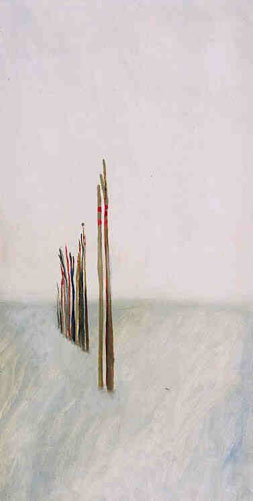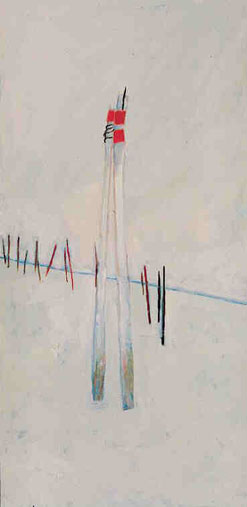



This series of paintings
was inspired by channel-marker poles that I
first saw a few years ago during a visit to White Head Island, which forms
part of the Bay of Fundy archipelago that includes Grand Manan.
During a trip across
to White Head on an exceptionally grey day, the
markers suddenly loomed out of the fog, guiding us to a hidden harbour.
I was immediately drawn
to these roughly hewn objects and their
directional markings and lashings. Although the poles serve a very practical
function as navigational aides, I disregarded their utility - I was attracted
to
their inherent totemic and sculptural qualities (something which they share
with the Bay of Fundy weirs) , primitive and elemental.
For me as a Maritimer,
the poles seemed to mark time as well as space,
pointing to a nearly lost way of life, one more firmly
connected to the
natural world. They spoke of crises of identity (both personal and
collective) and ecology.
As I worked on a series
of channel-marker paintings (first in Mahone Bay
and then in Ottawa), I also began to contemplate another marker of change
and the erosion of local culture: painted wooden buoys. Like the channel
markers, these were sculptural objects that served a utilitarian function,
but which could be invested with other meanings, serving as icons of
change.
As a Nova Scotian in exile, I navigated these waters for several months,
searching for signs
and meaning, trying to divine the future of a life
that was at once my heritage and something increasingly foreign to me.
I was searching for a
shoreline, a place that the Nova Scotian poet
Charles Bruce called "the cobalt blur of home." Eventually, I found
my way to
islands, my own archipelago - a place in the near distance, just out of reach.
Poles, buoys, a panorama
of islands in the harbour: all these things
flow from my engagement with exile and with my past, marking journeys home
-
and away. But enough text. One reason I am a painter is that I do not
entirely trust words.
Su Rogers
|
|
|
||